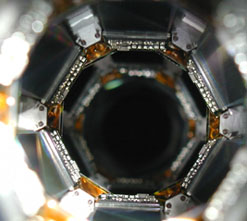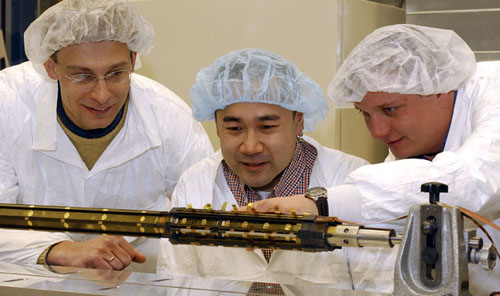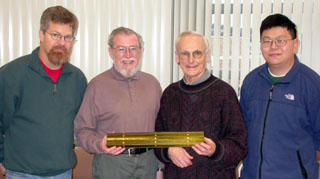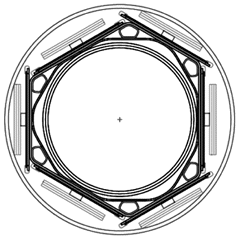 |
|
A New Layer of Sensitivity by Matthew Hutson
The particles produced in a high-energy particle collision usually decay into other particles, which sometimes decay into still other particles. By the time these leftovers have traversed the radius of the beam pipe and strike the surrounding silicon sensors, they're pretty much done with the show. From measuring the types and trajectories of these secondary (and tertiary) particles, physicists must reconstruct what happened inside the beam pipe. Fermilab scientists are adding a new front line to the battery of sensors inside the giant DZero detector. They've just completed the design of a new set of sensors, to be installed in a very confined space, which will give new life to the experiment. Slyly sitting outside the beam pipe but inside the existing sensors, the long carbon fiber tube covered in chips and wires will have two major impacts. First, it improve the detector's impact parameter resolution—how well the detector resolves the interaction point—by a factor of two; second, it will improve "b-tagging"—the identification of bottom quarks ejected from collisions—by 20%. Tagging b quark decays is important because the interesting heavy objects, such as Higgs and the top quark, decay into b quarks. This is one of the important features to distinguish the interesting Higgs or top decays from the very large rate of background events. The new detector could also help resolve the rapid flavor oscillations of the Bs meson that has so far eluded other detectors. DZero's original plans for a major upgrade to its silicon detector ended in September due to reallocation of funds, but DZero scientists quickly shifted gears and began preparing for a more modest improvement. The silicon sensors act as a first line of defense in the particle detector, and they take the most punishment from radiation. For about three feet in either direction along the beam pipe from the collision point, several layers of silicon sensors wrap around the beam pipe to a radius of about 16cm. The Central Fiber Tracker (CFT) sits outside the silicon detector, extending in radius from 20cm out to 52cm. Both trackers sit inside a solenoid magnet that bends the particle tracks, allowing physicists to determine their charge and momentum. Massive central and end cap calorimeters, which measure particle energies, surround the trackers.
Over the years, radiation damage will deteriorate the performance of the silicon sensors, and the full "Run IIb" plan called for replacing them all. The new Layer Zero plan calls for sliding one new layer of sensors inside layers 1-4. Sound simple? It's not. The scientists must install Layer Zero without disturbing any of the sensors already in place; indeed, without touching them. The inside of layer 1 is delicate silicon, so the group's backup plans cannot include greasing up Layer Zero with WD-40 and cramming the thing in. To say that the task resembles threading the eye of a needle would be inaccurate. The piece to be installed is 96 inches long and the hole is less than two inches wide. It's more like threading a row of 100 needles. A cross section of Layer Zero looks like a ring or donut, with an inner radius of 16mm and an outer radius of 22mm. The 6mm band in between (see drawing, Pg. 13) needs to hold a hexagonal support structure made of carbon fiber, one row of silicon sensors on each of the six sides, a cooling tube in each corner, and analog cables running from the silicon sensors to the ends of the tube. Lengthwise, 48 pieces of silicon will cover the middle three feet of the carbon fiber support structure, and for another foot in each direction, the structure will hold circuits called hybrids with readout chips mounted on them. These chips will translate the data from the sensors and analog cables into digital values that will run along special cables out to the ends of the detector, where they'll be combined with data from all the other silicon sensors. In most cases, the readout chips—in this case SVX4 chips, designed by Fermilab, Berkeley, and Padua —sit right on the silicon sensors, but here they won't for three reasons. Most important, there's no room. Second, the extra heat would warm the silicon sensors, making them more sensitive to radiation damage. And third, putting extra material in that area would increase unnecessary scattering of the particles. There is, however, a downside to this strategy. Namely, the analog cable connecting a sensor to a readout chip will act like an antenna and create noise in the low level analog signals. As Ron Lipton, co-project manager, joked, the cable will have "more sensitivity to picking up the local radio station." Still, scientists over at CDF first used this technique with their Layer Double-Zero (L 00) and have shown that it works, though they encountered considerable difficulties in interpretation of the data because of the pick-up noise.
Marvin Johnson, Run IIb technical coordinator at DZero, emphasized that the electrical and mechanical designs are "tightly coupled." He explained: "I like to think of the Layer Zero system as an integrated approach. There are no separate electrical or mechanical design meetings but rather joint design meetings. This is a somewhat unusual approach to detector design." With the amount of real estate available, geometry takes precedence. Andrei Nomerotski, a DZero scientist in charge of Layer Zero's electronics, said: "Everything depends on everything. I cannot change anything on the hybrid without negotiating it with mechanical group." Jim Fast of the Particle Physics Division backed him up: "When someone says, 'let's change the glue joint two thousandths of an inch,' it matters." Fast, in charge of production, acts as the superego keeping the package size within the 6 mm radial specification. "I'm the one who has to make sure it can get through the little hole," he said. "What really keeps me up at night," said Lipton, "is the question: will it really fit?" They have space contingency of a few hundred microns. "Installation," Lipton continued, "it's going to be an interesting time." "You have your good-hands people do it," added project co-manager Alice Bean of the University of Kansas. "Keep the physicists away."
Fermilab has begun ordering the parts from manufacturers. About a dozen universities are collaborating on the project. Some will purchase parts and test them. Kansas State University will build a lot of the electronics. The University of Washington will construct the carbon fiber support structure that holds all the elements together. Fermilab will then assemble the whole thing in the Silicon Detector facility. How did design work go so quickly? A lot of the plans carry over directly from the Run IIb design, and Fermilab has gained experience from DZero and CDF. "Fermilab has developed a lot of expertise in silicon in the past 10 years," said Bill Cooper, head of the DZero Silicon Mechanical Group. "It's a pleasure to see people who were novices 10 years ago gradually evolve into experts." (Matthew Hutson is an intern in Fermilab's Office of Public Affairs) Cover Photo: Prototype chip for Layer Zero. On the Web: Fermilab's DZero Experiment www-d0.fnal.gov
|
| last modified 2/5/2004 email Fermilab |
FRLsDFx9eyfrPXgV



